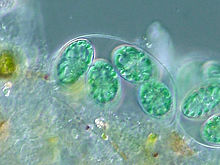- Glaucophyte
-
Glaucophyta 
Glaucocystis sp. Scientific classification Domain: Eukaryota (unranked): Archaeplastida Phylum: Glaucophyta
Skuja, 1954Class: Glaucophyceae
Bohlin, 1901Order: Glaucocystales
Bessey, 1907Family: Glaucocystaceae
G. S. West, 1904Possible genera - Glaucocystis
- Cyanophora
- Gloeochaete
The glaucophytes, also known as glaucocystophytes or glaucocystids, are a small group of freshwater microscopic algae.[1] Together with the red algae (Rhodophyta) and green algae plus land plants (Viridiplantae or Chloroplastida), they form the Archaeplastida. However, the relationships between the red algae, green algae and glaucophytes are unclear,[2] in large part due to limited study of the glaucophytes.
The glaucophytes are of interest to biologists studying the development of chloroplasts, because some studies suggest that they may be similar to the original alga type that led to green plants and red algae.[1][3]
Contents
Characteristics
The chloroplasts of glaucophytes are known as cyanelles. Unlike plastids in other organisms they have a peptidoglycan layer that is believed to be a relic of the endosymbiotic origin of plastids from cyanobacteria.[1] Glaucophytes contain the photosynthetic pigment chlorophyll a.[1] Along with red algae[1] and cyanobacteria they harvest light via phycobilisomes, structures consisting largely of phycobiliproteins. The green algae and land plants have lost that pigment.[not in citation given]
Glaucophytes have mitochondria with flat cristae, and undergo open mitosis without centrioles. Motile forms have two unequal flagella, which may have fine hairs and are anchored by a multilayered system of microtubules, both of which are similar to forms found in some green algae.
Genera
There are only 13 species of glaucophytes known, none of which is particularly common in nature.[1] The three included genera are:
- Glaucocystis is non-motile, though it retains very short vestigial flagella, and has a cellulose wall.
- Cyanophora is motile and lacks a cell wall.
- Gloeochaete has both motile and non-motile stages, and has a cell wall that does not appear to be composed of cellulose.
References
- ^ a b c d e f Patrick J. Keeling (2004). "Diversity and evolutionary history of plastids and their hosts". American Journal of Botany 91 (10): 1481–1493. doi:10.3732/ajb.91.10.1481. http://www.amjbot.org/cgi/content/full/91/10/1481.
- ^ Jeffrey D. Palmer, Douglas E. Soltis & Mark W. Chase (2004). "The plant tree of life: an overview and some points of view". American Journal of Botany 91 (10): 1437–1445. doi:10.3732/ajb.91.10.1437. PMID 21652302. http://www.amjbot.org/cgi/content/full/91/10/1437.
- ^ Eunsoo Kim & Linda E. Graham (2008). Redfield, Rosemary Jeanne. ed. "EEF2 Analysis Challenges the Monophyly of Archaeplastida and Chromalveolata" (Free full text). PLoS ONE 3 (7): e2621. doi:10.1371/journal.pone.0002621. PMC 2440802. PMID 18612431. http://www.plosone.org/article/info:doi/10.1371/journal.pone.0002621.
External links
- Guiry, M.D.; Guiry, G.M. (2008). "Glaucophyta". AlgaeBase. World-wide electronic publication, National University of Ireland, Galway. http://www.algaebase.org/browse/taxonomy/detail/?taxonid=4301.
Eukaryota Bikonta AH/SARAHSARHalvariaHeterokont ("S")Unikonta Apusomonadida (Apusomonas, Amastigomonas) · Ancyromonadida (Ancyromonas) · Hemimastigida (Hemimastix, Spironema, Stereonema)HolozoaFilozoaFilastereaChoanoflagellateaClassification of Archaeplastida / Plantae sensu lato Rhodophyta Cyanidiophyceae · Porphyridiophyceae · Compsopogonophyceae · Stylonematophyceae · Rhodellophyceae · Bangiophyceae · Florideophyceae (Hildenbrandiales, Acrochaetiales, Nemaliales, Batrachospermales, Corallinales, Gelidiales, Gracilariales, Ceramiales)Glaucocystophyceae Glaucocystis · Cyanophora · GloeochaeteViridiplantae/
Plantae
sensu strictoEuphyllophytaMoniliformopses (Equisetopsida, Filicopsida, Psilotopsida)
Spermatophyta: Gymnosperm (Pinophyta, Cycadophyta, Ginkgophyta, Gnetophyta) · MagnoliophytaCategories:
Wikimedia Foundation. 2010.
